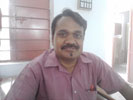Sunday, 19 August 2012
Steam Turbines - Construction of Nozzles and Diaphragm
Do you like this story?
Design requirements of nozzle:
- The design of nozzle should be such as to permit easy manufacturing and finishing and allow accurate channel sections to be obtained specially at the high pressure end of the turbine.
- The inlet of the nozzle should be so designed as to utilize the carry over energy from the previous stage to the largest possible extend.
- There should not be any sudden change in the direction of flowing steam, specially at high velocity.
- The shape and finish of the nozzle should be designed so that the conversion of thermal energy into kinetic energy should take place with greatest possible efficiency.
- In order to reduce friction, specially when the steam velocity is high, the valve surface should be as smooth as possible.
Construction of convergent nozzle:
First Stage Convergent Nozzle:
This segment consists of 6 nozzles and comprises a casting 'a' into which the nozzle guide vanes 'b' are embedded by 'casting in'. For casting of the guide vanes, they are first made from sheet metal of uniform thickness which is cut to save and then curved in press. With the correct shape and correct curvature at inlet, these are embedded in a sand core to form the steam passage. Then molten metal is poured into the mould which the projecting edges of the guide vanes are surrounded, on freezing of the metal, the vanes become firmly held and casting is taken out.
For this type of nozzle, rolled copper guide blades cast in gun metal nozzle segments are used for saturated steel. But for superheated steam steel or alloy steel must be used. In steel or alloy steel group materials such as low carbon, steel, 3-5% Nickel, stainless steel, Iron and hadfleld's hecla A.T.V. steel may be used.
Built-up Nozzle:
Built-up construction is shown in figure.
It provides an accurate nozzle segment. It consists of a number of vanes 'a', which are machined all over, and placed between curved angles 'b', likewise machined all over. The ends of segments are closed by pieces c of suitable shape. Through the rivets 'd' the guide vanes are attached to the angles. A small spigot 'e' is riveted over it.
It provides an accurate nozzle segment. It consists of a number of vanes 'a', which are machined all over, and placed between curved angles 'b', likewise machined all over. The ends of segments are closed by pieces c of suitable shape. Through the rivets 'd' the guide vanes are attached to the angles. A small spigot 'e' is riveted over it.
Diaphragm Nozzle:
A different type of built-up construction for high pressure diaphragm is shown in figure.
Each diaphragm contains a steel centre 'a', in halfes to which several nozzle elements 'b' are riveted as shown in figure. Each nozzle elements are machined all over to a fine finish.
Each diaphragm contains a steel centre 'a', in halfes to which several nozzle elements 'b' are riveted as shown in figure. Each nozzle elements are machined all over to a fine finish.
Construction Of Convergent-Divergent Nozzles:
De-Laval Nozzle:
It is a convergent-divergent type of nozzle made of gun metal as shown in figure.
The nozzle is fitted with a valve arrangement 'c' which opens or closes it to a steam chest 'a'. It is mostly used in experimental type of impulse turbine.
The nozzle is fitted with a valve arrangement 'c' which opens or closes it to a steam chest 'a'. It is mostly used in experimental type of impulse turbine.
Cast -in Type:
Cast-in type is shown in figure.
It is largely used in marine impulse turbine. Guide blades are rolled to the section shown by dotted lines in the upper part of figure, and then cut to shape and cast into the nozzle segment in the usual manner.
It is largely used in marine impulse turbine. Guide blades are rolled to the section shown by dotted lines in the upper part of figure, and then cut to shape and cast into the nozzle segment in the usual manner.
Built-up Nozzle:
Built-up nozzle is shown in figure.
It is made of steel to B.S.En 58B and is readily replaceable at any time. It consists of two parts- lower and upper forming rectangular cross-section. It is machined from a bar by employing jigs and fixtures to the required shape. It is used in many impulse turbines and another form of built up nozzles is also shown in figure.
It consists of 3 parts segment strips 'a' in which the nozzle passages are machined, a covering segment 'b' and a wedge piece 'c'. The locking screws 'd' on the ring 'c' causes the strips 'a' and 'b' to be forced against the steam chest. The cap nut 'e' covers the set screw 'd' so that there should not be any leakage. It is used in so many turbines.
It is made of steel to B.S.En 58B and is readily replaceable at any time. It consists of two parts- lower and upper forming rectangular cross-section. It is machined from a bar by employing jigs and fixtures to the required shape. It is used in many impulse turbines and another form of built up nozzles is also shown in figure.
It consists of 3 parts segment strips 'a' in which the nozzle passages are machined, a covering segment 'b' and a wedge piece 'c'. The locking screws 'd' on the ring 'c' causes the strips 'a' and 'b' to be forced against the steam chest. The cap nut 'e' covers the set screw 'd' so that there should not be any leakage. It is used in so many turbines.

This post was written by: Sanjay Verma
Sanjay Verma is an experienced mechanical engineer and a lecturer. In this blog he shares his knowledge about various subjects of mechanical engineering. Follow him on Google+
















